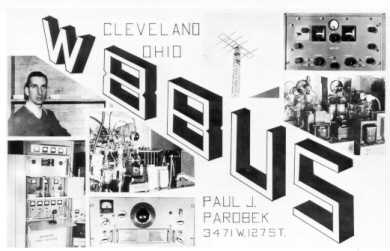ARS W8BUS circa 1946

Home Brew Picture QSL - 1946
This page has been accessed times since July 23, 1996.

Home Brew Picture QSL - 1946
This page has been accessed times since July 23, 1996.
Back then, towers were not readily available, so Paul and his brother constructed a 50' wood tower about 2' square. At the top was a 4 element 20 meter full size monobander on a wood frame. A prop pitch motor turned the antenna and even today the prop pitch is second to none in reliability and performance.
I can remember calling CQ at 4 years old and getting answers. Back then, not many AM kilowatts graced the airwaves so a big signal really stood out. But things have changed since those days. Hardly anyone homebrews their tx/rx anymore. If you have the money, you can set up a first class station with little effort. Back then, you spent more time working on your station than operating, but except for the big time contesters and a few others, that is not the case today.
So are we better off today than we were in 1946? Yes and no. The equipment is certainly much better but what about the substance of the hobby itself. Now all you hear is why some dx'ers don't like lists or don't like packet. They say that the quality of dx'ing isn't there when you take advantage of things that make working dx easy. There they sit with their World Class Japanese Radio with every filter you can imagine, stacked monobanders on all bands, 1000' beverages in all directions, digital signal processors; the list goes on and on. They feel that working a new one on their own is some accomplishment. But what was it like to work the DX in 1946? They don't have a clue. If they did, they wouldn't be telling the rest of us how they are so much better for doing it their way.
 Back to the EIDX Network
Back to the EIDX Network